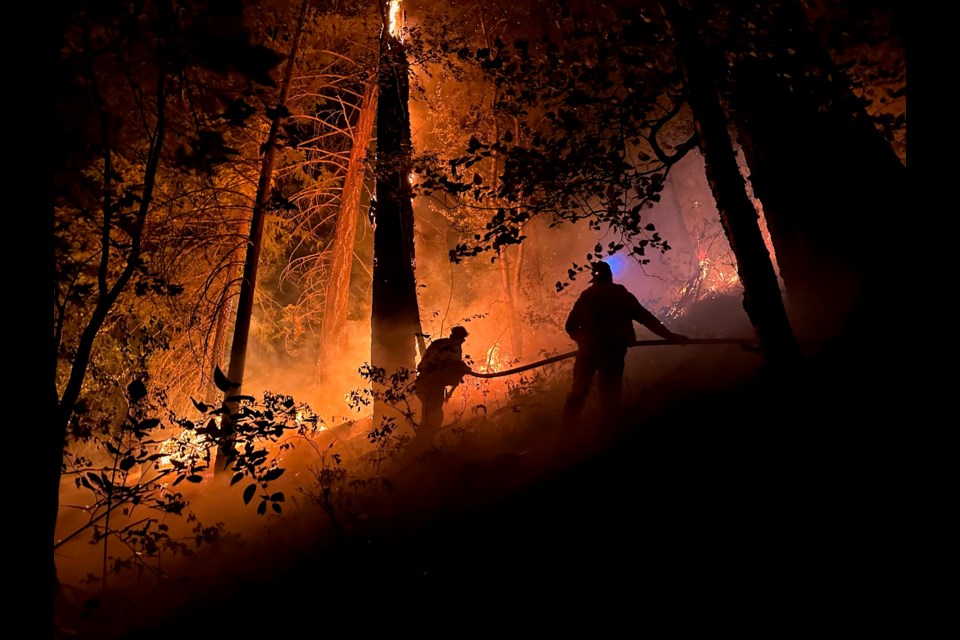The BC Wildfire Service’s (BCWS) use of a planned ignition during the 2023 Downton Lake wildfire was based on “sound forest practices and a reasonable assessment of wildfire threat.”
That was the Forest Practices Board’s findings released on Tuesday, May 13.
Back in November 2023, three Gun Lake residents submitted a complaint to the board—which serves as an independent watchdog for forest practices in B.C.—regarding the planned ignition used during the Downton Lake wildfire earlier that summer.
A planned ignition is the deliberate use of fire to remove unburned fuel during an emergency and help contain a wildfire. The complainants believed this was partly responsible for more than 40 homes that were destroyed on the lake’s west side.
"We recognize the devastating losses experienced by the people and community of Gun Lake," said Keith Atkinson, chair of the Forest Practices Board, in a release. "After a thorough review, we found that BC Wildfire Service acted within its legal authority, and its decision to conduct a planned ignition on Aug. 1, 2023, was reasonable given the circumstances and the threat the wildfire posed to the area.”
During the investigation, the board determined officials believed without the burn, the wildfire would have spread to the southwestern shore of the Lajoie and Gun Lakes, potentially reaching Gold Bridge.
The Downton Lake wildfire was caused by lightning and discovered on July 13, 2023. It started on the north side of the lake, about 10 kilometres west of Gold Bridge. BCWS moved into the area with an incident management team on July 26 to evaluate suppression tactics, including the use of a planned ignition. Three days later, they prepared an “ignition mission plan,” according to the report, on the Downton Lake side of Mount Penrose. “The eastern perimeter of the ignition was located approximately 1.2 kilometres west of the closest Gun Lake homes,” the report said.
While they planned to go ahead with the ignition, brand-new equipment for aerial ignitions failed. It was replaced with BCWS hoping to start the planned ignition on July 31. By that time, though, the wildfire had crossed an avalanche chute and was heading to Gun Lake’s southwestern shoreline—foiling their attempt that day.
Finally, on Aug. 1 they were able to conduct the burn by air and ground, but by the early afternoon weather and wind had changed, preventing them from finishing. “The objective of this planned ignition mission was to prevent the predicted fire growth on Aug. 1 from reaching its full natural potential, which would have encompassed almost the entire southwestern shoreline of Lajoie and Gun lakes and would have approached the community of Gold Bridge,” the report said. “BCWS believed that this outcome was inevitable without any suppression efforts.”
The fire continued to grow throughout the first half of August, thanks to hot, dry conditions. On Aug. 12, BCWS conducted a 50-hectare planned ignition near Walker Creek, but investigators found it didn’t increase the wildfire’s size.
In the end, the wildfire destroyed three properties on Aug. 1 and 40 more on Aug. 17-18. “Despite the significant losses, 246 properties in the Gun Lake and Lajoie Lake areas were spared from the wildfire’s impact,” the report said.
BCWS declared the wildfire out in late October.
“In this investigation, the Board considered whether BCWS complied with the fire control requirements set out in the Wildfire Act and evaluated the reasonableness of BCWS's decision to conduct a planned ignition in the vicinity of the complainants' properties on August 1, 2023,” the report said. “In summary, a BCWS official considered that the Downton Lake wildfire endangered life and threatened forest land, enabling BCWS to carry out fire control. Additionally, a designated BCWS official decided to introduce fire onto Crown land to reduce the likelihood of unwanted fire in the area between the Downton Lake wildfire and local communities.”
The report concluded: “The Board believes that BCWS’s decision was reasonable because it was consistent with sound forest practices, achieved the intent of the legislation and was based on an adequate assessment of available information.”
Read the full report at bcfpb.ca/release-publications/releases.



